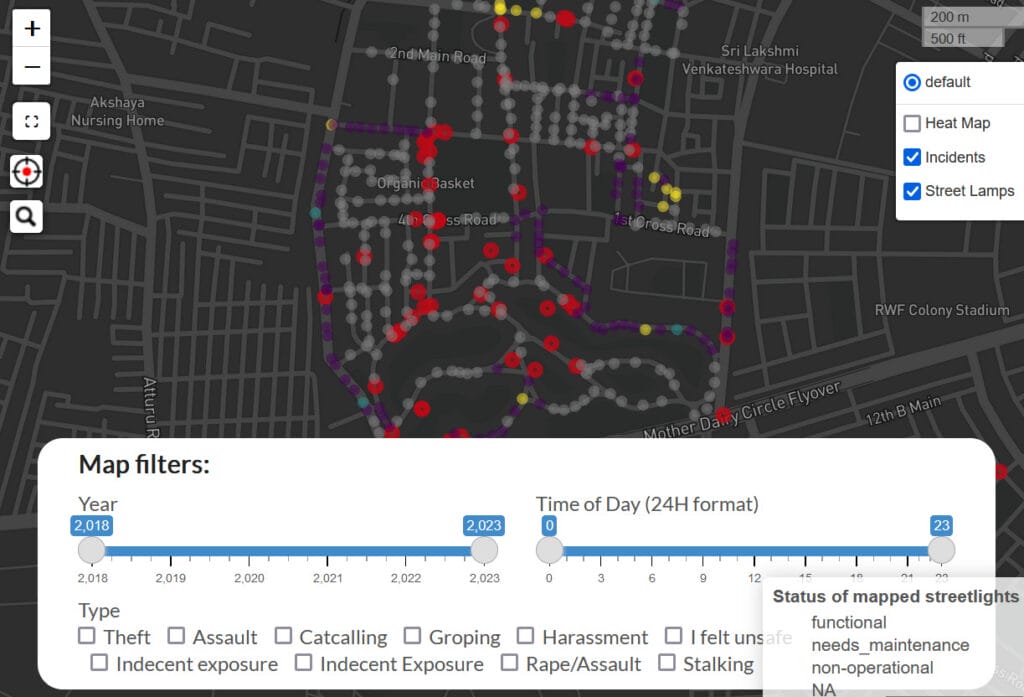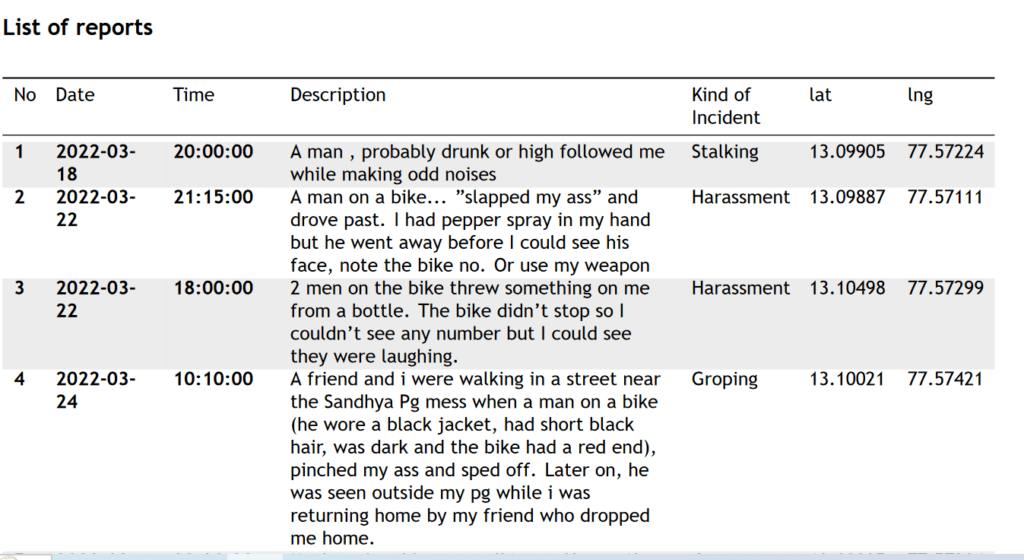Bengaluru ranked third in the country for crimes against women, according to the National Crime Records Bureau (NCRB) data for 2022. While the data is not clearly indicative of whether crimes are reported more or occurring more, it does beg the question, which areas in the city are safe?
Safe Yelli?, a citizen-led initiative, is hoping to answer this question. Safe Yelli? is an online tool that allows citizens to report personal experiences of sexual assault and harassment in Bengaluru. These experiences are then used to create a map of unsafe locations in the city.
Mapping harassment
The initiative started in 2021 at the Srishti School of Design in Yelahanka, according to Adhavan Sivaraj, the project lead at Safe Yelli? and a student at Srishti.
Srishti students used to be harassed routinely, especially when students lived in off-campus housing, such as PGs, until last year when the institute provided the students with hostels. “We used to get reports thrice or four times a week on a [Srishti] WhatsApp group.”

Students rarely reported crimes, especially harassment, because they didn’t see it translate to police action. Safe Yelli? began as a platform to document these experiences through a very simple online form that is integrated with Open Street Maps. To report harassment, you can click on the link and fill the form outlining your experiences, date and time and location. The platform is completely anonymous.
Since the platform began with Srishti, much of the current mapping has happened around North Bengaluru, in neighbourhoods like Yelahanka, Sahakarnagar and Canara Bank Layout. “We would like to spread across the city, but we don’t have the manpower for it right now,” says Adhavan.
To spread awareness about the tool and increase citizen participation, Safe Yelli? also holds bi-monthly events at different locations in the city to map unsafe spaces and sensitise citizens to the gendered nature of space use in the city. “We are also experimenting with various forms of data tagging, and methods to map Street Illumination, those experiments become part of our mapping events,” says Adhavan.
For instance, they collaborated with the Rotaract Club of Atria Institute of Technology last year during the Bengaluru Design Week to map public infrastructure, like footpaths and streetlights in Hebbal. They conducted a similar exercise in Indiranagar in December this year. “Our hope is to cohesively develop an active community around such neighbourhoods.”
The group is also hoping to go beyond just documenting harassment and provide users with support during incidents, according to Adhavan. For instance, they are collaborating with Reap Benefit to build a WhatsApp bot that could lead users to the nearest police station or possible list of support centres. “The WhatsApp bot will probably be operational by mid to end January. We are testing it currently.”
Safe Yelli? is also focused on reaching more colleges and the student community in the city. “Students, especially outstation students, are most vulnerable because they can’t speak the language, they don’t have family here and may not always be supported by the college administration,” adds Adhavan.
Challenges and potential
The team is, however, facing its share of challenges. “The main issue is getting the word out,” Adhavan points out. Encouraging users to remember and document traumatic events that occur to them is difficult. “It’s not something that can be easily advertised.”
Read more: Police to get massive surveillance project to make Bengaluru a ‘Safe City’ for women
But citizen-involved planning and mapping exercises will be crucial to urban planning or crime deterrence going forward, according to Adhavan.
IN A NUTSHELL
Who can report harassment on Safe Yelli?
Safe Yelli? is a volunteer-driven group. They run a website where women and other citizens can document incidents of sexual harassment anonymously
Where should harassment be reported?
Click on this link-https://safeyelli.in/report/
What should be mentioned?
Your experiences, date, time and location. The platform is completely anonymous
What is done with the experiences registered on Safe Yelli?
The incidents are mapped to create a better understanding of which areas are safe. Red dots on the map are areas of harassment incidents. This information can be used for better policing or infra like streetlights
Who has reported incidents so far?
Currently, most incidents have been reported by Srishti students around North Bengaluru. But they are trying to spread the word to the rest of the city
Does the group conduct events?
They also run bi-monthly events across the city where citizens can map neighbourhoods and how safe they are
Which localities have been mapped so far?
They have mapped locations in Hebbal and Indiranagar so far
Can I volunteer with Safe Yelli?
They are now looking for volunteers. If you have faced harassment or want to help make Bengaluru safe, get in touch at safeyelli@gmail.com
You can check out safeyelli.in or get in touch with the team at safeyelli@gmail.com or on Instagram or X (Twitter).
Citizens need access to granular data
In 2019, following a similar exercise by another Srishti student, who mapped harassment zones in the city, the Bengaluru police promised to scale up the study. But no such study has emerged, at least in the public domain.
Meanwhile, the police is ramping up CCTV coverage and has introduced Surakhsa boxes – a literal box with a button that can be pressed to reach the police control room in case of emergencies. Most of these Suraksha boxes have been placed on main busy roads, like Church Street, but these choices have raised more questions.
These questions form the basis for Safe Yelli? explains Adhavan. “This is the core of why citizens need granular access to such data, to understand where and what kind of incidents go unpoliced/ignored/unreported.”
“We do see ourselves participating in the design and conversation around such initiatives. What is the rationale behind Suraksha SOS posts? Where will the growing number of CCTVs be placed? Is the policing infrastructure equipped to identify and handle different forms of crime in the increasingly large peripheries of the city? Supporting can only happen when more urban planners, legal / field experts on crime deterrence work with us.”
